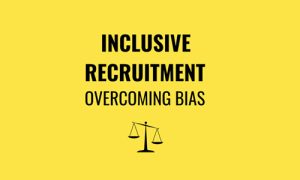 As humans and as recruiters, we are filled with countless decision-making moments. When we reply to an email, we decide what to say; when we get a job that needs candidates, we decide how to advertise it; when we review CV’s, we decide who is “good for the job”; when we choose who to call, when we send candidates to our clients…
As humans and as recruiters, we are filled with countless decision-making moments. When we reply to an email, we decide what to say; when we get a job that needs candidates, we decide how to advertise it; when we review CV’s, we decide who is “good for the job”; when we choose who to call, when we send candidates to our clients…
We are so used to making decisions that some of them become unconscious, here is when the different types of bias in recruitment appear. Some of us tend to make quick decisions without taking enough time to value the situation, leading us to be unconsciously biased.
A bias is an inclination or prejudice for or against one person or group, especially in a way considered to be unfair. In recruitment a bias would cause us to make decisions based on the first impression a candidate gives, this could be their profile picture, their CV, their showreel/portfolio of work, their accents, their gender, or their ethnicity.
We can encounter bias in all aspects of the recruitment process, and if we do not identify them and fight against them, we will fail in inclusive hiring.
Here are the types of bias you should watch out for!
- Confirmation bias – type of cognitive bias that involves favouring information that confirms your previously existing beliefs or biases.
- Heuristic – judges someone’s job suitability by superficial factors such as visible tattoos or personal body weight standards.
- Affinity bias – when you unconsciously prefer people who share qualities with you or someone you like.
- Conformity Bias – is the tendency people must behave like those around them rather than using their own personal judgment.
- Intuition – When an interviewer makes a judgment based on his, her or their “sixth sense”, he is intuitively selecting a candidate or in other words, intuitively rejecting all other candidates.
Sadly, is very easy to fall into being unconsciously biased. Therefore, it is extremely important to be aware of the types of bias we may encounter and how to avoid them. In order to implement inclusive hiring and diversity, we must work hard to eliminate these bias as they can lead to inaccurate and unfair judgements, and discrimination.
Overcoming unconscious bias can be difficult but it isn’t impossible, some things you can implement in your recruitment process are:
- Taking a good amount of time to make decisions. Quick decision making can result in poor judgements or opinions.
- Have a second (or more) pair of eyes look at the candidates you pick to ensure you were fair and inclusive.
- Honesty is important, if you feel like you are being biased, ask for help. It is good to take accountability to improve in the future.
- Try to review CV’s with an open mind and not looking at things like ethnicity or gender. What is important is the skills and capabilities the candidates have, not how they look or talk.
- Educate yourself and others more in inclusive hiring! Read, go to events, do a workshop, and share your knowledge with your colleagues to be as diverse and inclusive as possible.
Look at how Yellow Cat started on their DEIB journey:
https://www.yellowcat.london/inclusive-hiring-strategy/
https://www.yellowcat.london/diversity-and-inclusion-strategy/
If you would like to learn more about DEIB and inclusive hiring, you can also check out:
https://balanceandinclusion.com/
https://business.linkedin.com/talent-solutions/diversity-equity-inclusion
https://training.talent.linkedin.com/page/webinars#language_english,topic_diversity
https://business.linkedin.com/talent-solutions/diversity-inclusion-belonging/creating-equal-access-to-opportunity
https://www.linkedin.com/business/talent/blog/talent-acquisition/ways-to-make-real-progress-on-diversity-equity-and-inclusion?_l=en_US&src=re-other&veh=statics.teams.cdn.office.net%7Cre-other
Inclusive hiring for the screen industries – ScreenSkills